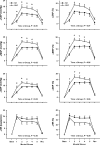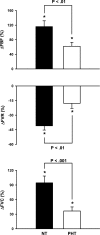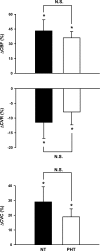Neurovascular responses to mental stress in prehypertensive humans
- PMID: 21051574
- PMCID: PMC3253011
- DOI: 10.1152/japplphysiol.00912.2010
Neurovascular responses to mental stress in prehypertensive humans
Abstract
Neurovascular responses to mental stress have been linked to several cardiovascular diseases, including hypertension. Mean arterial pressure (MAP), muscle sympathetic nerve activity (MSNA), and forearm vascular responses to mental stress are well documented in normotensive (NT) subjects, but responses in prehypertensive (PHT) subjects remain unclear. We tested the hypothesis that PHT would elicit a more dramatic increase of MAP during mental stress via augmented MSNA and blunted forearm vascular conductance (FVC). We examined 17 PHT (systolic 120-139 and/or diastolic 80-89 mmHg; 22 ± 1 yr) and 18 NT (systolic < 120 and diastolic < 80 mmHg; 23 ± 2 yr) subjects. Heart rate, MAP, MSNA, FVC, and calf vascular conductance were measured during 5 min of baseline and 5 min of mental stress (mental arithmetic). Mental stress increased MAP and FVC in both groups, but the increases in MAP were augmented (Δ 10 ± 1 vs. Δ14 ± 1 mmHg; P < 0.05), and the increases in FVC were blunted (Δ95 ± 14 vs. Δ37 ± 8%; P < 0.001) in PHT subjects. Mental stress elicited similar increases in MSNA (Δ7 ± 2 vs. Δ6 ± 2 bursts/min), heart rate (Δ21 ± 3 vs. Δ18 ± 3 beats/min), and calf vascular conductance (Δ29 ± 10 vs. Δ19 ± 5%) in NT and PHT subjects, respectively. In conclusion, mental stress elicits an augmented pressor response in PHT subjects. This augmentation appears to be associated with altered forearm vascular, but not MSNA, responses to mental stress.
Figures




Similar articles
-
Sex differences in sympathetic neural and limb vascular reactivity to mental stress in humans.Am J Physiol Heart Circ Physiol. 2013 Feb 1;304(3):H436-43. doi: 10.1152/ajpheart.00688.2012. Epub 2012 Nov 30. Am J Physiol Heart Circ Physiol. 2013. PMID: 23203970
-
Combined heat and mental stress alters neurovascular control in humans.J Appl Physiol (1985). 2010 Dec;109(6):1880-6. doi: 10.1152/japplphysiol.00779.2010. Epub 2010 Sep 30. J Appl Physiol (1985). 2010. PMID: 20884834 Free PMC article.
-
Sympathetic neural responses to mental stress: responders, nonresponders and sex differences.Am J Physiol Heart Circ Physiol. 2009 Mar;296(3):H847-53. doi: 10.1152/ajpheart.01234.2008. Epub 2009 Jan 23. Am J Physiol Heart Circ Physiol. 2009. PMID: 19168718 Free PMC article.
-
Sympathetic neural reactivity to mental stress in offspring of hypertensive parents: 20 years revisited.Am J Physiol Heart Circ Physiol. 2016 Aug 1;311(2):H426-32. doi: 10.1152/ajpheart.00378.2016. Epub 2016 Jul 1. Am J Physiol Heart Circ Physiol. 2016. PMID: 27371684 Free PMC article.
-
Fish oil and neurovascular control in humans.Am J Physiol Heart Circ Physiol. 2012 Aug 15;303(4):H450-6. doi: 10.1152/ajpheart.00353.2012. Epub 2012 Jun 15. Am J Physiol Heart Circ Physiol. 2012. PMID: 22707560 Free PMC article. Clinical Trial.
Cited by
-
Total sleep deprivation alters cardiovascular reactivity to acute stressors in humans.J Appl Physiol (1985). 2012 Sep;113(6):903-8. doi: 10.1152/japplphysiol.00561.2012. Epub 2012 Jul 19. J Appl Physiol (1985). 2012. PMID: 22815387 Free PMC article. Clinical Trial.
-
Sympathetic neural reactivity to mental stress in humans: test-retest reproducibility.Am J Physiol Regul Integr Comp Physiol. 2015 Dec 1;309(11):R1380-6. doi: 10.1152/ajpregu.00344.2015. Epub 2015 Sep 23. Am J Physiol Regul Integr Comp Physiol. 2015. PMID: 26400186 Free PMC article.
-
Elevated resting blood pressure augments autonomic imbalance in posttraumatic stress disorder.Am J Physiol Regul Integr Comp Physiol. 2018 Dec 1;315(6):R1272-R1280. doi: 10.1152/ajpregu.00173.2018. Epub 2018 Oct 10. Am J Physiol Regul Integr Comp Physiol. 2018. PMID: 30303706 Free PMC article.
-
Impaired hemodynamic response to mental stress in subjects with prehypertension is improved after a single bout of maximal dynamic exercise.Clinics (Sao Paulo). 2011;66(9):1523-9. doi: 10.1590/s1807-59322011000900003. Clinics (Sao Paulo). 2011. PMID: 22179153 Free PMC article.
-
Autonomic and Vascular Control in Prehypertensive Subjects with a Family History of Arterial Hypertension.Arq Bras Cardiol. 2018 Feb;110(2):166-174. doi: 10.5935/abc.20180006. Epub 2018 Feb 19. Arq Bras Cardiol. 2018. PMID: 29466485 Free PMC article.
References
-
- Anderson EA, Wallin BG, Mark AL. Dissociation of sympathetic nerve activity in arm and leg muscle during mental stress. Hypertension 9: III114–III119, 1987 - PubMed
-
- Barcroft H, Brod J, Hejl BZ, Hirsjarvi EA, Kitchin AH. The mechanism of the vasodilatation in the forearm muscle during stress (mental arithmetic). Clin Sci 19: 577–586, 1960 - PubMed
-
- Boutcher YN, Park YJ, Boutcher SH. Vascular and baroreceptor abnormalities in young males with a family history of hypertension. Eur J Appl Physiol 107: 653–658, 2009 - PubMed
Publication types
MeSH terms
Grants and funding
LinkOut - more resources
Full Text Sources
Medical
Research Materials

